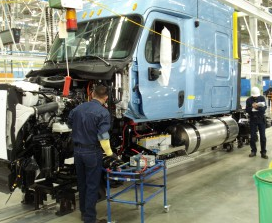Truck & Bus Manufacturing in Canada Tumbles Says IBISWorld Report
According to a new research report just released, in the five years leading up to 2013, the Truck and Bus Manufacturing industry in Canada faced plummeting demand, beginning with the economic turmoil in 2008.
“Industry demand heavily relies on the success of the United States, the industry’s largest trade partner,” says IBISWorld industry analyst Brandon Ruiz. As the US economy dove during the recession, industry revenue followed suit. To this end, revenue is expected to decline at an average annual rate of 14.9% to $2.4 billion in the five years to 2013, with a jump of 1.2% in 2013 alone.
Unlike the United States, Canada’s strong banking sector allowed the economy to avoid significant declines in GDP. However, the same cannot be said for the Truck and Bus Manufacturing industry. Because of the relative strength of the Canadian economy during the recession, investors sought refuge in the Canadian dollar, consequently appreciating the currency and making domestic goods more expensive for foreign countries. Because exports account for a significant portion of industry revenue, the Canadian dollar’s higher value effectively reduced industry demand.
The Truck and Bus Manufacturing industry in Canada has a medium level of concentration. The three top players are PACCAR Inc., Navistar International and New Flyer Industries Inc. Over the past five years, the three top players have remained dominant despite plummeting industry revenue because these companies’ revenue fell line with the industry as a whole. To this end, market share concentration has remained largely unchanged.
 “IBISWorld expects concentration to change in the future only if the top industry operators cannot meet the emissions standard benchmarks,” continues Ruiz. The rising price of crude oil, a major input for truck and bus users, along with emissions regulations, are forcing the industry to innovate and develop new engine technologies. Because Canadian emission standards are harmonized with US regulations, industry operators are forced to invest more in research and development and incur additional compliance costs, which pose a threat to profitability. On the other hand, if Canadian emissions regulations were not harmonized with the stringent US standards, operators would be at a competitive disadvantage because they would not be providing their biggest market with a relevant product.
“IBISWorld expects concentration to change in the future only if the top industry operators cannot meet the emissions standard benchmarks,” continues Ruiz. The rising price of crude oil, a major input for truck and bus users, along with emissions regulations, are forcing the industry to innovate and develop new engine technologies. Because Canadian emission standards are harmonized with US regulations, industry operators are forced to invest more in research and development and incur additional compliance costs, which pose a threat to profitability. On the other hand, if Canadian emissions regulations were not harmonized with the stringent US standards, operators would be at a competitive disadvantage because they would not be providing their biggest market with a relevant product.
Not all is bad news for truck and bus manufacturers, though. As the United States continues to recover, consumers are expected to increase spending, leading to higher overall demand and trade activity, which will bolster demand for freight transportation and provide a significant bump in industry revenue. More information at: IBSWorld.
Category: General Update










